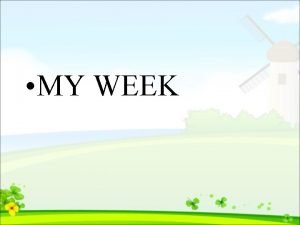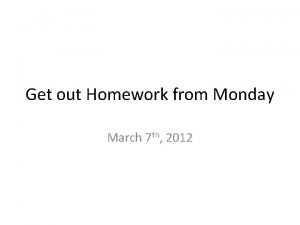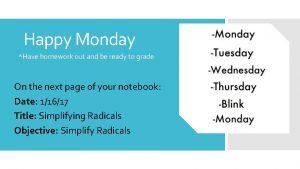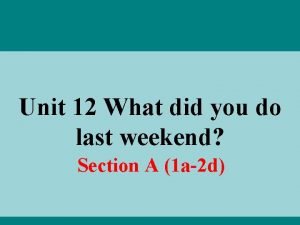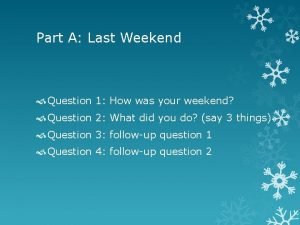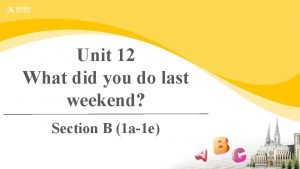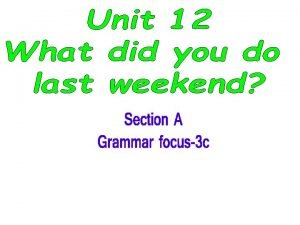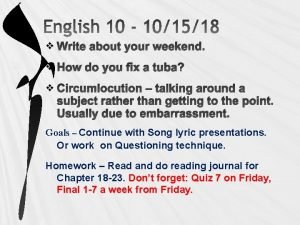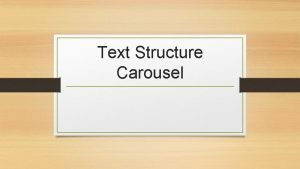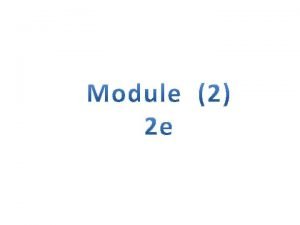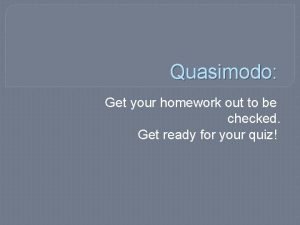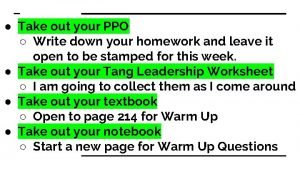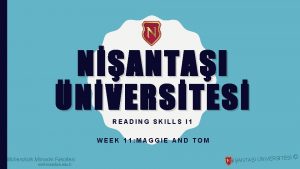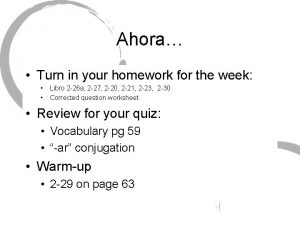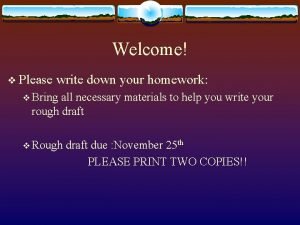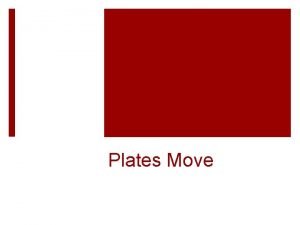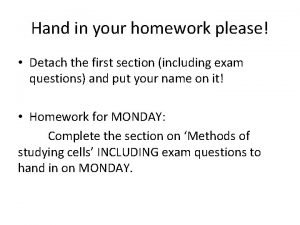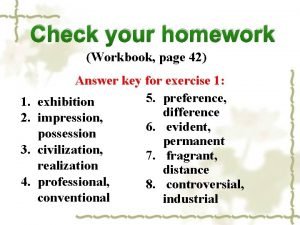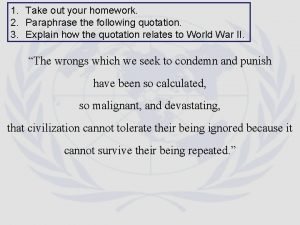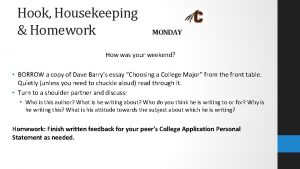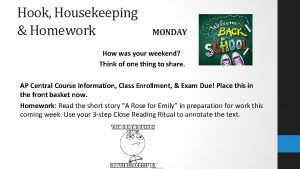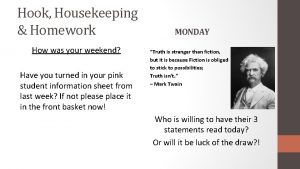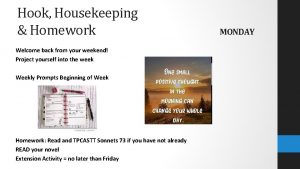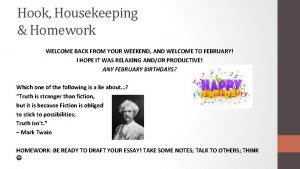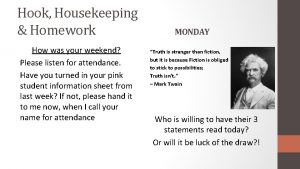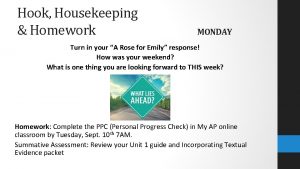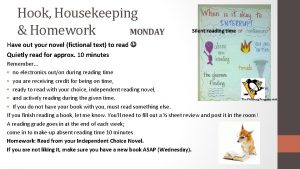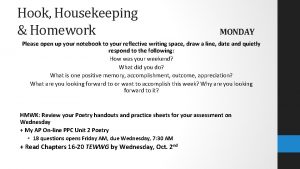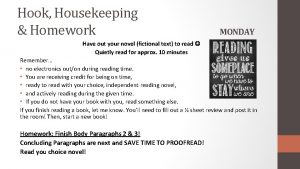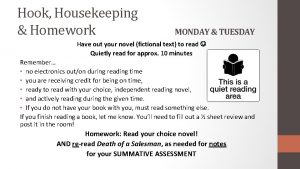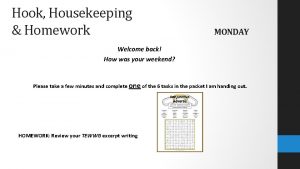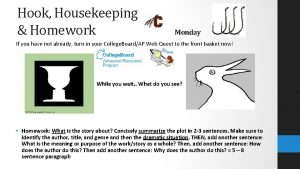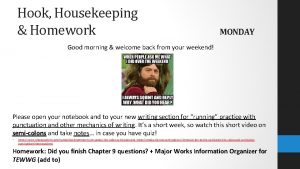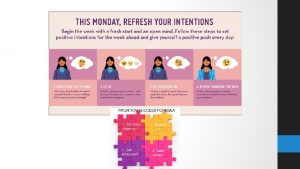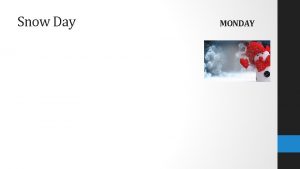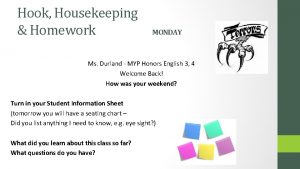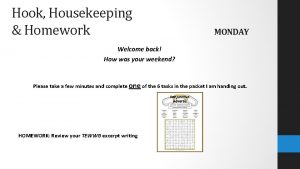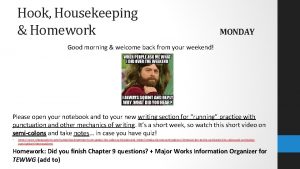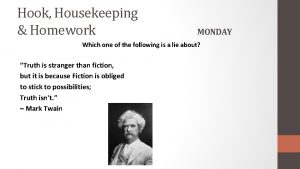Hook Housekeeping Homework MONDAY How was your weekend












































- Slides: 44

Hook, Housekeeping & Homework MONDAY How was your weekend? Which one of the following is a lie about……? “Truth is stranger than fiction, but it is because Fiction is obliged to stick to possibilities; Truth isn't. ” – Mark Twain

Past, Present, Future MONDAY • • Marxist Lens - Chart Short Story “The Necklace” Incorporating Textual Evidence (embedding quotes) Historical/Biographical Lens Feminist Lens • Feminist Lens - Continue • Historical/Biographical Lens - Continue • “The Story of an Hour” by Kate Chopin • Short Constructed Response • brief essay that supports a thesis through the feminist lens

Short Stories Through a Critical Lens Standard 2. Reading for All Purposes 1. Literary criticism of complex texts requires the use of analysis, interpretive, and evaluative strategies Objective: to establish understanding of the background for the Feminist Lens Relevance: By interpreting complex texts, providing evidence, and communicating ideas, we are not only practicing the skills need in any workplace or postsecondary setting, but also we are examining aspects of ourselves and others and how these as well as social and historical events impact the way in which we communicate. By learning to examine situations from different perspectives, we open ourselves to recognizing, understanding, explaining, and judging the ways in which we, as well as others, conduct ourselves, in order to more productively function in an every changing world. Inquiry Questions: How does one’s perspective influence the reading of a text? How does reading from a particular perspective influence what is seen as important within a text and how characters, events, and theme are understood? What are five types of critical lenses? How were they established? How are they defined? How would a feminist/gender critic approach and respond to this text? How would a historical/biographical critic approach this text?

Activity: Review Possible Responses • Review information women’s progress/feminist waves (Women and Public Life PPT and “A History of Western Feminism. . . in 101 Seconds” video https: //www. youtube. com/watch? v=pn. ETKMum 9 K 4 Outcome: What did you note? • Weight of clothing – working conditions – few educational opportunities (20%) - American Medical Association didn’t admit women - Working-class and uneducated women took industry jobs that paid less than men, as employers assumed women were being supported by their fathers - National Association of Colored Women (NACW), in 1896 - Fifteenth Amendment granted voting rights to African American men but not to women - Some believed women were too frail to handle the turmoil of polling places on Election Day - Some believed voting would interfere with a woman’s duties at home or destroy families; Some claimed that women did not have the education or experience to be competent voters - Women nationwide finally won the vote in 1920 • Movement to obtain legal, political, social rights; belief that woman should have same rights, powers, opportunities • 3 Waves • 1800 s Mandated inequalities, political rights – suffrage • 1960 s Liberation, unofficial, legal social inequalities - workplace, reproduction, divorce • 1990 s Essentialism - upper, middle class, white women – gender violence, derogatory terms • Right to vote

Activities: Develop and Apply Purpose: to identify the components of another critical lens = Feminist Perspective (and how it can be applied to “The Story of an Hour” as well as examine the historical/biographical connections) Tasks: Facts about Kate Chopin • View biographical information about Kate Chopin (Kate Chopin and Feminism (A brief overview) 2: 45 https: //www. youtube. com/watch? v=j. Qf 4 y. CPda. Tk • Examine “Historical/Biographical Overview of Kate Chopin” PPT (see grey slides – next - or printed copies in class) Outcome: Coming SOON Complete a Historical/Biographical Chart – We’ll do this once we have read the story!!

Instruction: Obtain Purpose: to obtain brief background information before reading the story Tasks: 1. Preview https: //app. studysync. com/admin/library/index. cfm#preview 2. Overview Kate Chopin (1850 -1904) wrote stories and novels about women with wants and needs beyond just marriage and child-rearing, which cast her as one of the boldest and most controversial authors of her time. Her works, never widely read or critically lauded during her lifetime, have since been reappraised and canonized as precursors of 20 th-century feminist literature and ideology. The Story of an Hour, tells the tale of a woman who finds liberation when she receives the news of her husband's unexpected death. Review vocabulary (see next slide) Outcome: Ready to read the story!

Vocabulary Afflicted af • flict • ed ə ˈflik təd adjective To cause pain or suffering to We provided water to the runners who were afflicted by the extreme heat. Intelligence in • tel • li • gence in ˈtel ə jən(t)s noun Information that is delivered, news The spies brought us intelligence about the enemy’s battle plans. Abandonment aban • don • ment ə ˈban dən mənt noun The state of acting freely or in an unrestrained manner We danced with abandonment on hearing that we had won the lottery. Elusive elu • sive ē ˈlü səv adjective Difficult to hold onto or understand She read the sentence several times to try to grasp its elusive meaning. Illumination il • lu • mi • na • tion ə lü mə ˈnā shən noun Clarity or understanding, enlightenment Discovering new connections between the facts led to a feeling of illumination for the scholar. Imploring im • plor • ing im ˈplō(ə)r ing verb (participle) Begging or requesting in an urgent, passionate manner The homeless man was imploring people for spare change. Elixir elix • ir ə ˈlik sə(r) noun A liquid or other substance thought to have special, often magical powers The aging explorer searched far and wide for an elixir of youth. Importunities im • por • tu • ni • ties im pər ˈtü nə tēz noun Repeated annoying requests or demands We grew so tired of our neighbor’s constant importunities that we make no noise when he was home. • Grip-sack = travel bag

Activity: Develop & Apply Purpose: to identify and describe what specific textual details reveal about a character, that character’s perspective and motives through a feminist lens. Tasks: • Read, discuss, & annotate Chopin’s “The Story of an Hour. ” • Look for Details = This text has been divided into four short sections by line breaks ----. At each line break, stop and annotate the text for details about the character Mrs. Mallard: What does the section reveal about Mrs. Mallard? What additional information is revealed about her in each new section? Outcome: Use the Active Reading Guide to review the story. Be prepared to share out ideas on 21 -26. You will write a brief essay about this story this week!

Review & Release

Hook, Housekeeping & Homework TUESDAY Which one of the following is a lie about……? “Truth is stranger than fiction, but it is because Fiction is obliged to stick to possibilities; Truth isn't. ” – Mark Twain

Past, Present, Future TUESDAY • Short Story - “The Story of an Hour” • Character – Ms. Mallard • Historical/ Biographical Lens & Short Story “The Story of an Hour” - Continued • Plot and Feminist Lens Discussions • Lens: Feminist Lens & Short Story “The Story of an Hour” • Short Constructed Response • brief essay that supports a thesis through the feminist lens

Short Stories Through a Critical Lens Standard 2. Reading for All Purposes 1. Literary criticism of complex texts requires the use of analysis, interpretive, and evaluative strategies Objective: to apply the components of the Historical/Biographical lens to the “The Story of an Hour” Relevance: By interpreting complex texts, providing evidence, and communicating ideas, we are not only practicing the skills need in any workplace or postsecondary setting, but also we are examining aspects of ourselves and others and how these as well as social and historical events impact the way in which we communicate. By learning to examine situations from different perspectives, we open ourselves to recognizing, understanding, explaining, and judging the ways in which we, as well as others, conduct ourselves, in order to more productively function in an every changing world. Inquiry Questions: What strategies are most useful when reading, understanding, making personal connections to, and analyzing texts? What are five types of critical lenses? How were they established? How are they defined? How does one’s perspective influence the reading of a text? How does reading from a particular perspective influence what is seen as important within a text and how characters, events, and theme are understood? How would a feminist/gender critic approach and respond to this text? How would a historical/biographical critic approach this text?

Activity: Develop & Apply Kate Chopin (1850 -1904) wrote stories and novels about women with wants and needs beyond just marriage and child-rearing, which cast her as one of the boldest and most controversial authors of her time. Her works, never widely read or critically lauded during her lifetime, have since been reappraised and canonized as precursors of 20 th-century feminist literature and ideology. The Story of an Hour, tells the tale of a woman who finds liberation when she receives the news of her husband's unexpected death. Objective: to apply the components of the Historical/Biographical lens to “The Story of an Hour Tasks: 1. Use your notes on history of feminism as well as the additional PPT biographical information on Kate Chopin to complete your Historical/Biographical chart. 2. Additionally, use the Active Reading Guide to review the story • NOTE: Sorry, but not all of the paragraph numbering matches up, but it is not hard to figure out; I have faith you can do it Outcome: You should have enough background information so we can more onto 21 – 26 (in 15 minutes)

Historical/Biographical Overview of Kate Chopin 1850 - 1904

Birth& Family Childhood • Katherine O’Flaherty was born in St. Louis, Missouri on February 8, 1850 • Her mother came from an impoverished French Creole family and, because of hard times and the need for financial support, married her father at 16. She gave him legitimacy in the French Creole aristocracy. • St. Louis in the 1850 s harbored the spirit of a fur-trading town, and the city was growing as waves of settlers passed through to the West • Her father, an Irish merchant, furnished settlers with boats and supplies and provided his family a substantial living • In 1855, Chopin entered the St. Louis Academy of the Sacred Heart and was taught by Catholic nuns. The nuns at the convent provided her with an elite education for French intellectual women. This was unusual, given that most girls didn’t go to school at all. • That same year on All Saints Day, her father was killed in a train accident. Thomas O’Flaherty joined city leaders in celebration of a new line of the Pacific Railroad. Just as the train crossed a bridge, the structure buckled, plunging into a river. Chopin’s father and 29 others were killed. • Chopin was raised in a household run solely by women. She lived with her mother, grandmother, and great-grandmother, all of them widows – smart and independent single women Role Models • Her great-grandmother Mme. Victoire Charleville, lived with them and taught her music and French • Victoire’s mother had been the first woman in St. Louis to obtain legal separation from her husband, after which she raised her children and ran a shipping business on the Mississippi.

Tragedies Early Adulthood Marriage • In 1861 the Civil War broke out. One story goes that during the war, sympathies were for the South. Chopin tore down an American flag and almost went to jail for her act. • In 1863, her grandmother died on Christmas Day, as did her half-brother George of typhoid fever. He died on Mardi Gras Day. • Some say these unhappy incidents combined to create a strong skepticism of religion in Chopin. • In 1868, Chopin graduated from Sacred Heart Academy , the top of her class. She won medals, was elected into the elite Children of Mary Society, and delivered the commencement address. • From 1869 – 1870 she attended debutante parties, learned to smoke, and wrote her first story, “Emancipation: A Life Fable, ” a short story about freedom and restriction • In 1870, at the age of 20, she married Oscar Chopin, the son of a wealthy cottongrowing family in Louisiana. • He adored her and admired her independence and intelligence, giving her unheard of freedom. • They lived in New Orleans where she had five boys and two girls.

Family Challenges Writing Responses to Her Works • Oscar was not an able businessman and in 1879 his work with the cotton exchange was down because of the war. So they moved to his old home in a small Louisiana parish to run a general store and small plantation. • In 1882, Oscar died of swamp fever, leaving her with heavy debt so she took over running the store and plantation for over a year. • In 1884, Chopin sold up and moved back to St. Louis to live with her mother. • Her mother died the next year, leaving Chopin alone with her children again. • To support herself and her young family, she began to write. • In the 1880 s, writing was one of the few ways women could make a living, averaging $15 - $30 a story, and few hundred dollars for a novel. • There was great demand for short fiction and one of the genres that was most popular was “local color, ” which offered descriptions of the varied parts of the country. She wrote and sold numerous short stories about people she had known in Louisiana. • Chopin sold her first novel in 1890 and followed this with stories, essays and sketches in literary magazines. Early in her career, she was very successful. Her social world expanded and her home became a literary center. • In 1899, she wrote The Awakening, one of her most famous works about a female protagonist, exploring what happens when a woman experiences her own sexual being and her own self. Unfortunately, the content and message caused an uproar and Chopin was denied admission into the St. Louis Fine Art Club. She was deeply hurt by the reaction to her work.

Critical Rejection Death • The critical reviews and adverse reactions to her work devastated Chopin. • For the remaining five years of her life, she retreated into private life and sank into obscurity. She wrote four more short stories, only one of which was published. • On August 22, 1904, Chopin visited the World’s Fair that had come to St. Louis. • After returning home that night, she collapsed. Two days later, she died. • The official cause of death was a cerebral hemorrhage. • Many of Chopin’s works focus on themes related to women’s search for selfhood, for self-discovery or identity. • Many also focus on women’s revolt against conformity, often against gender Major Themes conformity or against social norms that limit women’s possibilities in life. in Her Work • Others write about women’s understanding of feminine sexuality or women’s experience of motherhood, pregnancy, or childbirth.

• Kate Chopin did not characterize herself as a feminist or a suffragist. Nonetheless, she was a woman who took women seriously. She never doubted women’s ability to be strong, and she embraced the ideas of spirit, character, and living life within the constraints the world makes for you. • Although Kate Chopin published her stories in the 1890 s, her texts did not gain acceptance in the American literary canon until the late twentieth century, corresponding with the rise of feminist criticism as a mode of literary discourse. Feminism

Bibliography http: //americanliterature. com/author/kate-chopin/biobooks-stories http: //www. vcu. edu/engweb/webtexts/hour/katebio. html http: //www. katechopin. org/faq/ http: //www. katechopin. org/themes/ http: //www. pbs. org/katechopin/interviews. html

Short Stories Through a Critical Lens Standard 2. Reading for All Purposes 1. Literary criticism of complex texts requires the use of analysis, interpretive, and evaluative strategies Objective: to identify plot and characters for the short story “The Story of an Hour” and review/apply feminist lens. Relevance: By interpreting complex texts, providing evidence, and communicating ideas, we are not only practicing the skills need in any workplace or postsecondary setting, but also we are examining aspects of ourselves and others and how these as well as social and historical events impact the way in which we communicate. By learning to examine situations from different perspectives, we open ourselves to recognizing, understanding, explaining, and judging the ways in which we, as well as others, conduct ourselves, in order to more productively function in an every changing world. Inquiry Questions: How does one’s perspective influence the reading of a text? How does reading from a particular perspective influence what is seen as important within a text and how characters, events, and theme are understood? What are five types of critical lenses? How were they established? How are they defined? How would a feminist/gender critic approach and respond to this text? How would a historical/biographical critic approach this text?

Activity: Develop & Apply Purpose: to draw some conclusions about the story through a feminist lens Tasks: Use the Active Reading Guide discuss the story Let’s talk about questions 23 - 26 You will write a brief essay about this story this week and these questions will help you generate ideas for it! Outcome: See next

Activities: Develop We Do Purpose: to gain an understanding of the story through others and to see how a small group analyzes literature using illustrations, explanation, and elaboration. Task: Watch Sync. TV Discussion (10: 46) • various interpretation of the story's final line: "When the doctors came they said she had died of heart disease-of the joy that kills. " What is your opinion? • the point of view employed in this story, and how it changes over the course of the narrative. What is the story's point of view? How does Chopin construct meaning with the story's shifting point of view? • interpretations of the story are divided into two distinct camps: at 0: 10 -0: 50 we are introduced to both sides of the argument. Consider both viewpoints and think about your own personal responses to Chopin's ambiguous narrative.

Review & Release Outcome: What new or different or “controversial” understandings do you have of the story?

Hook, Housekeeping & Homework Which one of the following is a lie about…? “Truth is stranger than fiction, but it is because Fiction is obliged to stick to possibilities; Truth isn't. ” – Mark Twain HOMEWORK: BE READY TO DRAFT YOUR ESSAY! TAKE SOME NOTES; TALK TO OTHERS; THINK

Past, Present, Future • Short Story - “The Story of an Hour” • Character – Ms. Mallard • Historical/ Biographical Lens & Short Story “The Story of an Hour” - Continued • Lens: Feminist Lens & Short Story “The Story of an Hour” • Short Constructed Response • Prompt - Scoring Guide/Rubric - Models - Draft Outline • Short Constructed Response • Draft Outline • Practice Incorporating Quotes (turn this in) • Write brief essay that supports a thesis through the feminist lens • Turnitin. com – JOIN THE CLASS - TURN YOUR ESSAY IN ON TME!

Short Stories Through a Critical Lens Standard 2. Reading for All Purposes 1. Literary criticism of complex texts requires the use of analysis, interpretive, and evaluative strategies Objective: to apply the components of the feminist lens to the “The Story of an Hour” Relevance: By interpreting complex texts, providing evidence, and communicating ideas, we are not only practicing the skills need in any workplace or postsecondary setting, but also we are examining aspects of ourselves and others and how these as well as social and historical events impact the way in which we communicate. By learning to examine situations from different perspectives, we open ourselves to recognizing, understanding, explaining, and judging the ways in which we, as well as others, conduct ourselves, in order to more productively function in an every changing world. Inquiry Questions: What strategies are most useful when reading, understanding, making personal connections to, and analyzing texts? What are five types of critical lenses? How were they established? How are they defined? How does one’s perspective influence the reading of a text? How does reading from a particular perspective influence what is seen as important within a text and how characters, events, and theme are understood? How would a feminist/gender critic approach and respond to this text? How would a historical/biographical critic approach this text?

Instruction: Obtain I Do Purpose: to examine the expectations for your Short Constructed Response (SCR = micro-theme): “The Story of an Hour” Through a Feminist Lens Tasks: • Prompt + Scoring Guide/Rubric • Model + Outline Outcome: Questions? Tomorrow is an in-class writing and “help” day! See next for Turnitin. com information

Model: SCR 2 Sent. Intro. & Body 1 Nathaniel Hawthorne’s short story “Young Goodman Brown” portrays Faith as a loving and worrisome wife, while Goodman Brown is seemingly strong and determined. These portrayals reveal a stereotypical view of women and men in the Puritan period, much different than today’s view. Of the two main female characters, Faith is presented as good and loving wife. For example. Faith, who wears pink ribbons and is “aptly named, ” asks Brown to put off his journey as “a lone woman is troubled with such dreams and thoughts that she’s afeard of herself sometimes. ” (1) Her name, Faith, represents that she is “faithful” to her husband God. Faith’s hair ribbons, a stereotypical pink often associated with girls, also associates her with feminine innocence. She is supposed to represent an adoring, dutiful wife. While being adoring and faithful are not bad traits, through a feminist perspective, this portrayal of women is one-dimensional. This limit role of women, as housewives and spiritual instructors, reflects Hawthorne's Puritan background.

Model: 5 Paragraph SCR (Micro-Theme) Nathaniel Hawthorne’s short story “Young Goodman Brown” portrays Faith as a loving and worrisome wife, while Goodman Brown is seemingly strong and determined. These portrayals reveal a stereotypical view of women and men in the Puritan period, much different than today’s view. Of the two main female characters, Faith is presented as good and loving wife. For example. Faith, who wears pink ribbons and is “aptly named, ” asks Brown to put off his journey as “a lone woman is troubled with such dreams and thoughts that she’s afeard of herself sometimes. ” (1) Her name, Faith, represents that she is “faithful” to her husband God. Faith’s hair ribbons, a stereotypical pink often associated with girls, also associates her with feminine innocence. She is supposed to represent an adoring, dutiful wife. While being adoring and faithful are not bad traits, through a feminist perspective, this portrayal of women is onedimensional. This limit role of women, as housewives and spiritual instructors, reflects Hawthorne's Puritan background. While Faith at first appears in a positive way, she is also shown as a nervous woman. . . …. . In the story……. . This interaction reveals……… Young Goodman Brown, on the other hand, is shown as a strong and determined man and husband. For instance……. . This action shows………. In many ways, the character portrayals in this story reveal a stereotypical, archaic view of women as passive followers, and a traditional view of men as patriarchal protectors and “doers. ” Over one hundred years later, the reader still can contemplate the roles individuals assume in a marriage. While love, faith, and determination are important in any relationship, they are not necessarily seen as gender specific today.

Instruction: Obtain English 8 Period 4 Please enroll in my turnitin. com class ID KEY = 22350710 Durland 4 • English 8 Period 5 = 22350761 Durland 5 • English 8 Period 7 = 22350784 Durland 7

Hook, Housekeeping & Homework THURSDAY Which one of the following is a lie about…? “Truth is stranger than fiction, but it is because Fiction is obliged to stick to possibilities; Truth isn't. ” – Mark Twain HOMEWORK: Are you done with your draft outline? Continue to work on your draft so that you are done before the weekend!

Past, Present, Future THURSDAY • Historical/ Biographical Lens & Short Story “The Story of an Hour” - Continued • Feminist Lens & Short Story “The Story of an Hour” • Short Constructed Response • Prompt - Scoring Guide/Rubric - Models - Draft Outline • Short Constructed Response (Micro-theme essay) • Draft Outline • Short Constructed Response (Micro-theme essay) • Practice Incorporating Quotes (turn this in) • Feminist Lens: “Girl” by Jamaica Kincaid • Short Constructed Response (Micro-theme essay) • LAB – Proper Heading & Assignment Title, Times New Roman, 12 point font, double-spaced • Print a hard copy & staple the rubric on top • Turnitin. com copy • TURN BOTH COPIES OF YOUR ESSAY IN ON TME!

Short Stories Through a Critical Lens Standard 2. Reading for All Purposes 1. Literary criticism of complex texts requires the use of analysis, interpretive, and evaluative strategies Objective: to apply the components of the feminist lens to the “The Story of an Hour” Relevance: By interpreting complex texts, providing evidence, and communicating ideas, we are not only practicing the skills need in any workplace or postsecondary setting, but also we are examining aspects of ourselves and others and how these as well as social and historical events impact the way in which we communicate. By learning to examine situations from different perspectives, we open ourselves to recognizing, understanding, explaining, and judging the ways in which we, as well as others, conduct ourselves, in order to more productively function in an every changing world. Inquiry Questions: What strategies are most useful when reading, understanding, making personal connections to, and analyzing texts? What are five types of critical lenses? How were they established? How are they defined? How does one’s perspective influence the reading of a text? How does reading from a particular perspective influence what is seen as important within a text and how characters, events, and theme are understood? How would a feminist/gender critic approach and respond to this text? How would a historical/biographical critic approach this text?

Activity: Develop & Apply Outline Your Micro-theme! How are women and men portrayed in this text? What does that reveal? And/or why is this important/what is the purpose? Introductory Paragraph 1 • Closed Thesis • Explanation of purpose/importance Body Paragraph 2 • Point 1 (e. g women portrayal 1) • Illustration 1 (quote/example from story) • Explanation 1 • Concluding Sentence Body Paragraph 3 • P 2 • I 2 • E 2 • Concluding Sentence Body Paragraph 4 • P 3 • I 3 • E 3 • Concluding Sentence Conclusion Paragraph 5 - What does this story reveal? And/or why is this important/what is the purpose? Today?

Model: SCR 2 Sent. Intro. & Body 1 Nathaniel Hawthorne’s short story “Young Goodman Brown” portrays Faith as a loving and worrisome wife, while Goodman Brown is seemingly strong and determined. These portrayals reveal a stereotypical view of women and men in the Puritan period, much different than today’s view. Of the two main female characters, Faith is presented as good and loving wife. For example. Faith, who wears pink ribbons and is “aptly named, ” asks Brown to put off his journey as “a lone woman is troubled with such dreams and thoughts that she’s afeard of herself sometimes. ” (1) Her name, Faith, represents that she is “faithful” to her husband God. Faith’s hair ribbons, a stereotypical pink often associated with girls, also associates her with feminine innocence. She is supposed to represent an adoring, dutiful wife. While being adoring and faithful are not bad traits, through a feminist perspective, this portrayal of women is one-dimensional. This limit role of women, as housewives and spiritual instructors, reflects Hawthorne's Puritan background.

Model: 5 Paragraph SCR (Micro-Theme) Nathaniel Hawthorne’s short story “Young Goodman Brown” portrays Faith as a loving and worrisome wife, while Goodman Brown is seemingly strong and determined. These portrayals reveal a stereotypical view of women and men in the Puritan period, much different than today’s view. Of the two main female characters, Faith is presented as good and loving wife. For example. Faith, who wears pink ribbons and is “aptly named, ” asks Brown to put off his journey as “a lone woman is troubled with such dreams and thoughts that she’s afeard of herself sometimes. ” (1) Her name, Faith, represents that she is “faithful” to her husband God. Faith’s hair ribbons, a stereotypical pink often associated with girls, also associates her with feminine innocence. She is supposed to represent an adoring, dutiful wife. While being adoring and faithful are not bad traits, through a feminist perspective, this portrayal of women is onedimensional. This limit role of women, as housewives and spiritual instructors, reflects Hawthorne's Puritan background. While Faith at first appears in a positive way, she is also shown as a nervous woman. . . …. . In the story……. . This interaction reveals……… Young Goodman Brown, on the other hand, is shown as a strong and determined man and husband. For instance……. . This action shows………. In many ways, the character portrayals in this story reveal a stereotypical, archaic view of women as passive followers, and a traditional view of men as patriarchal protectors and “doers. ” Over one hundred years later, the reader still can contemplate the roles individuals assume in a marriage. While love, faith, and determination are important in any relationship, they are not necessarily seen as gender specific today.

Instruction: Obtain English 8 Period 4 Please enroll in my turnitin. com class ID KEY = 22350710 Durland 4 • English 8 Period 5 = 22350761 Durland 5 • English 8 Period 7 = 22350784 Durland 7

Hook, Housekeeping & Homework FRIDAY Which one of the following is a lie about…? “Truth is stranger than fiction, but it is because Fiction is obliged to stick to possibilities; Truth isn't. ” – Mark Twain HOMEWORK: Are you done with your draft outline? We are typing the FINAL copy in the lab Monday and turning it in, so get it done!

Past, Present, Future FRIDAY • Historical/ Biographical Lens & Short Story “The Story of an Hour” - Continued • Feminist Lens & Short Story “The Story of an Hour” • Short Constructed Response • Prompt - Scoring Guide/Rubric - Models - Draft Outline • Draft Outline • Short Constructed Response (Micro-theme essay) • Practice Incorporating Quotes (turn this in) • Feminist Lens: “Girl” by Jamaica Kincaid • Short Constructed Response (Micro-theme essay) • LAB – Proper Heading & Assignment Title, Times New Roman, 12 point font, double-spaced • Print a hard copy & staple the rubric on top • Turnitin. com copy • TURN BOTH COPIES OF YOUR ESSAY IN ON TME!

Short Stories Through a Critical Lens Standard 2. Reading for All Purposes 1. Literary criticism of complex texts requires the use of analysis, interpretive, and evaluative strategies Objective: to apply the components of the feminist lens to the “The Story of an Hour” Relevance: By interpreting complex texts, providing evidence, and communicating ideas, we are not only practicing the skills need in any workplace or postsecondary setting, but also we are examining aspects of ourselves and others and how these as well as social and historical events impact the way in which we communicate. By learning to examine situations from different perspectives, we open ourselves to recognizing, understanding, explaining, and judging the ways in which we, as well as others, conduct ourselves, in order to more productively function in an every changing world. Inquiry Questions: What strategies are most useful when reading, understanding, making personal connections to, and analyzing texts? What are five types of critical lenses? How were they established? How are they defined? How does one’s perspective influence the reading of a text? How does reading from a particular perspective influence what is seen as important within a text and how characters, events, and theme are understood? How would a feminist/gender critic approach and respond to this text? How would a historical/biographical critic approach this text?

Activity: Develop & Apply Purpose: to review and practice the ways in which you should incorporate textual evidence and embed quotes into an essay. Tasks: • Have out the packet on “INCORPORATING QUOTATIONS CORRECTLY” (lilac) • Have out “Practice” sheet (white) where we already practiced incorporating quotes from “The Necklace” • Use the textual evidence, quotes, you plan to use in your Short Constructed Response for the short story “The Story of an Hour” to practice these quotation skills on the practice sheet • Use the second set of lines for each of the 4 ways to incorporate quotes • If time allows, they can swap practice papers with someone else and “grade” each other by making corrections to punctuation etc. Outcome: Turn this in

Activity: Develop & Apply Purpose: to apply a reader response and a feminist lens to a new text Tasks: 1. Hand out the worksheet for “Girl” 2. Individual Complete… 1. Pre-Reading: Write “Agree” or “Disagree” for the statements below. 2. Pre-Reading: Read the biography excerpt 3. As a Class Complete… 1. Read “Girl” by Jamaica Kincaid aloud 2. Discuss the questions for “Girl” by Jamaica Kincaid 3. Reflect 4. Individually Complete… 1. Reflect in Writing Outcome: Turn in

Review & Release MONDAY = LAB • Short Constructed Response (Micro-theme essay) • LAB – Proper Heading & Assignment Title, Times New Roman, 12 point font, doublespaced • Print a hard copy & staple the rubric on top • Turnitin. com copy • TURN BOTH COPIES OF YOUR ESSAY IN ON TME!
 How _________ your last weekend?
How _________ your last weekend? Saturday sunday monday tuesday wednesday thursday friday
Saturday sunday monday tuesday wednesday thursday friday Happy monday hope you had a great weekend
Happy monday hope you had a great weekend Have you finished your homework?
Have you finished your homework? Homework for monday
Homework for monday Simplify √150
Simplify √150 Where did they go last weekend
Where did they go last weekend Jack prelutsky homework oh homework
Jack prelutsky homework oh homework Homework oh homework i hate you you stink
Homework oh homework i hate you you stink Parts of a poem
Parts of a poem Jack prelutsky homework oh homework
Jack prelutsky homework oh homework Homework oh homework i hate you you stink
Homework oh homework i hate you you stink Literal language
Literal language What you last weekend?
What you last weekend? Write about your plans for the weekend
Write about your plans for the weekend Weekend questions and answers
Weekend questions and answers Did you enjoy the weekend
Did you enjoy the weekend Did you finish your homework sally
Did you finish your homework sally Bestie party.com
Bestie party.com What did you do this weekend
What did you do this weekend How about weekend
How about weekend Give us your hungry your tired your poor
Give us your hungry your tired your poor What do finding nemo and robocop have in common
What do finding nemo and robocop have in common Take out your homework
Take out your homework How often do you do homework
How often do you do homework Please put your homework my desk
Please put your homework my desk Homework out
Homework out Take out your homework
Take out your homework Your homework please
Your homework please Hand up homework
Hand up homework Take out your homework
Take out your homework Take out your homework
Take out your homework When do you do your homework answer
When do you do your homework answer Write down your homework
Write down your homework Maggie hi tom have you finished your homework
Maggie hi tom have you finished your homework Let's check your answers
Let's check your answers Turn in your homework
Turn in your homework Turn in your homework
Turn in your homework Write down your homework
Write down your homework Hand in your homework
Hand in your homework Comic strip about plate movement
Comic strip about plate movement Please hand in your homework
Please hand in your homework Check your homework
Check your homework Take out your homework
Take out your homework Write down your homework
Write down your homework

